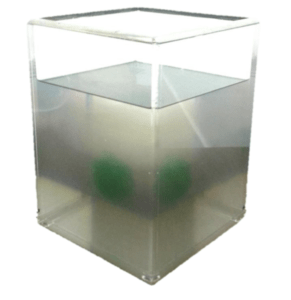Photograph of experimental model employed to study 2-phase NAPL remediation
Methodology for optical imaging of 3D multiphase liquid distribution was developed. The natural aquifer is simulated using a transparent soil surrogate that represents the macroscopic behavior of natural sand. To achieve transparency transparent fused quartz grains were saturated with a matched refractive index mineral oil solution that represents the natural aquifer and injected with a green-dyed sucrose solution to simulate dense NAPL contamination. The spatial volume was first estimated and then reconstructed using orthogonal images acquired at the model boundaries at various stages of contamination and remediation (see flow analysis in technologies tab).
Color space analysis steps to estimate spatial concentration profile.
Color space analysis was employed to segment the NAPL zone and transform pixel information into integrated concentration values using a previously published calibration model. The chromatic components CR and a of YCBCR and Lab, respectively, were combined to render the spatial concentration profile. A novel iterative reconstruction algorithm named 3D carving was used to resolve three 2D projections into a 3D model. The developed technology is a sustainable, fast, accurate, non-intrusive, and inexpensive method for spatial mapping of contamination zones using bench-scale transparent soil models.
3D reconstruction of NAPL zone of model shown in Fig. 1 above (1,000,000 voxels).
(Slices at different level (i) from top to bottom of model. Note that white space shown in levels 57 ± 5 is caused by air bubbles)
PRIMARY REFERENCES
- Kashuk, S., R. Mercurio, and M. Iskander (2015). Methodology for optical imaging of 3D NAPL distribution in transparent porous media. Geotechnical Testing Journal, Vol. 38, No. 5, doi: 10.1520/GTJ20140153, ASTM [link]
- Kashuk, S., R. Mercurio, and M. Iskander (2014). Visualization of dyed NAPL concentration in transparent porous media using color space components. Journal of Contaminant Hydrology, Vol. 162-163, pp. 1-16, doi: 10.1016/j.jconhyf.2014.04.001, Elsevier [link]
- Fernandez-Serrano, R., M. Iskander, and K. Tabe (2011). Contaminant flow imaging in transparent granular porous media. Geotechnique Letters, Vol. 1, No. 3, pp. 71-78, doi: 10.1680/geolett.11.00027,ICE [link]
- Lo, Hung-Chieh (Jay), K Tabe, M. Iskander, & S. Yoon (2010) “Modeling of 2D multiphase flow and surfactant flushing using transparent aquabeads,” Geotechnical Testing J., Vol. 33, No. 1, pp. 1-13, doi: 10.1520/GTJ102375, ASTM.



